Michael Schmuker
Neuromorphic circuit for temporal odor encoding in turbulent environments
Dec 28, 2024Abstract:Natural odor environments present turbulent and dynamic conditions, causing chemical signals to fluctuate in space, time, and intensity. While many species have evolved highly adaptive behavioral responses to such variability, the emerging field of neuromorphic olfaction continues to grapple with the challenge of efficiently sampling and identifying odors in real-time. In this work, we investigate Metal-Oxide (MOx) gas sensor recordings of constant airflow-embedded artificial odor plumes. We discover a data feature that is representative of the presented odor stimulus at a certain concentration - irrespective of temporal variations caused by the plume dynamics. Further, we design a neuromorphic electronic nose front-end circuit for extracting and encoding this feature into analog spikes for gas detection and concentration estimation. The design is inspired by the spiking output of parallel neural pathways in the mammalian olfactory bulb. We test the circuit for gas recognition and concentration estimation in artificial environments, where either single gas pulses or pre-recorded odor plumes were deployed in a constant flow of air. For both environments, our results indicate that the gas concentration is encoded in -- and inversely proportional to the time difference of analog spikes emerging out of two parallel pathways, similar to the spiking output of a mammalian olfactory bulb. The resulting neuromorphic nose could enable data-efficient, real-time robotic plume navigation systems, advancing the capabilities of odor source localization in applications such as environmental monitoring and search-and-rescue.
The Neuromorphic Analog Electronic Nose
Oct 24, 2024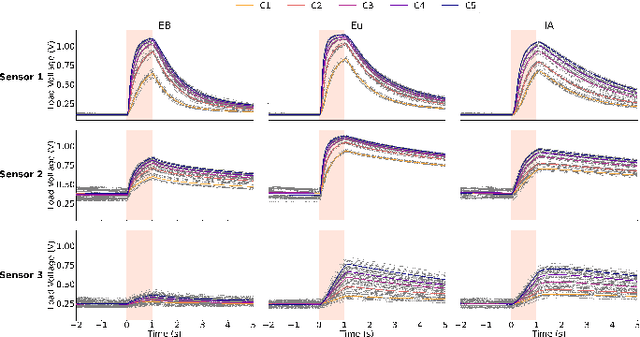
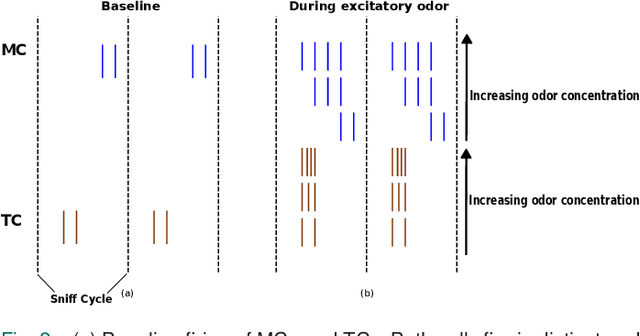
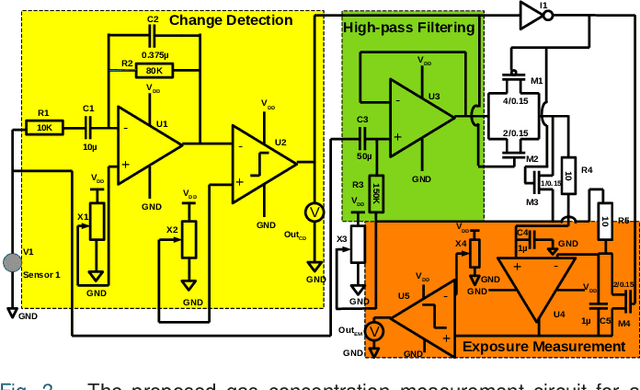
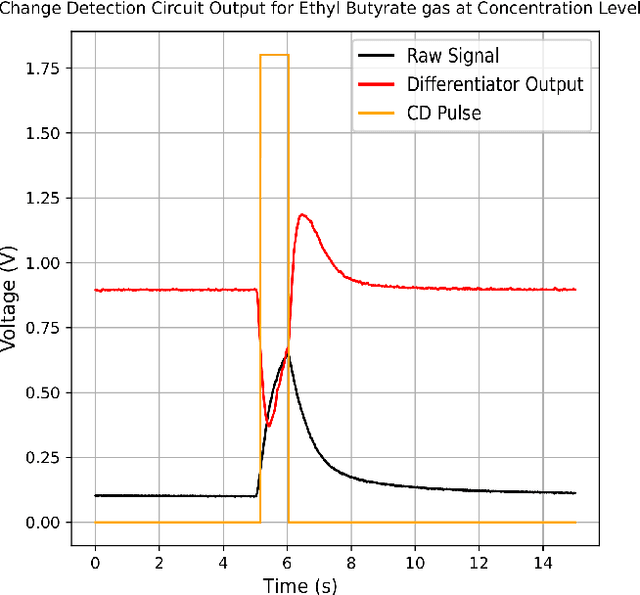
Abstract:Rapid detection of gas concentration is important in different domains like gas leakage monitoring, pollution control, and so on, for the prevention of health hazards. Out of different types of gas sensors, Metal oxide (MOx) sensors are extensively used in such applications because of their portability, low cost, and high sensitivity for specific gases. However, how to effectively sample the MOx data for the real-time detection of gas and its concentration level remains an open question. Here we introduce a simple analog front-end for one MOx sensor that encodes the gas concentration in the time difference between pulses of two separate pathways. This front-end design is inspired by the spiking output of a mammalian olfactory bulb. We show that for a gas pulse injected in a constant airflow, the time difference between pulses decreases with increasing gas concentration, similar to the spike time difference between the two principal output neurons in the olfactory bulb. The circuit design is further extended to a MOx sensor array and this sensor array front-end was tested in the same environment for gas identification and concentration estimation. Encoding of gas stimulus features in analog spikes at the sensor level itself may result in data and power-efficient real-time gas sensing systems in the future that can ultimately be used in uncontrolled and turbulent environments for longer periods without data explosion.
High-speed odour sensing using miniaturised electronic nose
Jun 04, 2024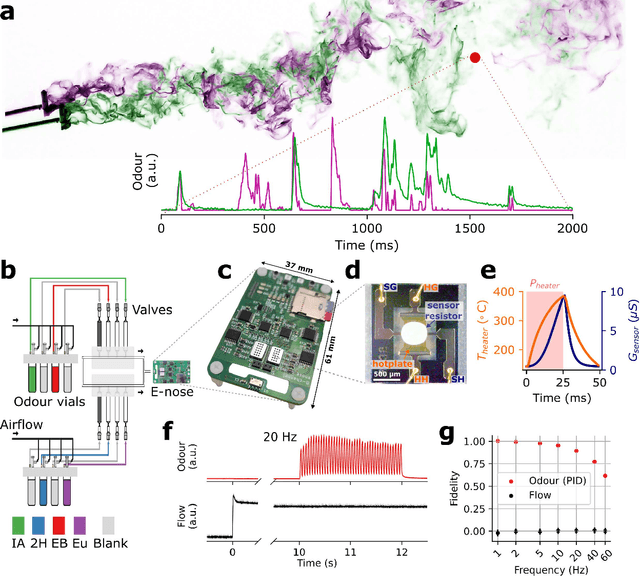

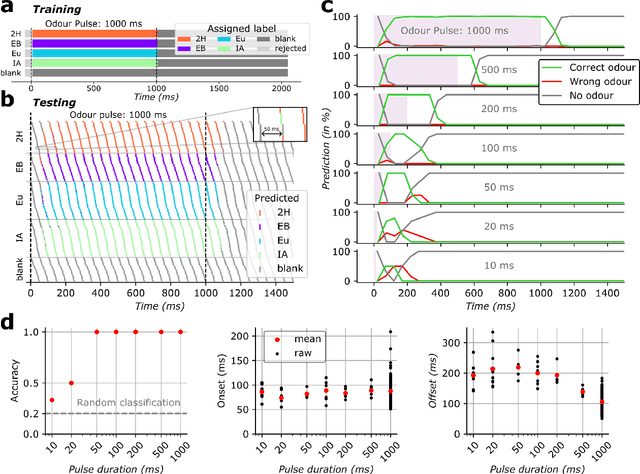
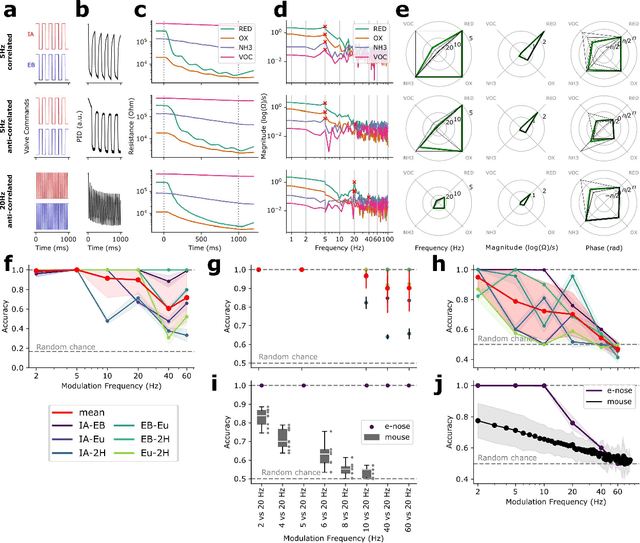
Abstract:Animals have evolved to rapidly detect and recognise brief and intermittent encounters with odour packages, exhibiting recognition capabilities within milliseconds. Artificial olfaction has faced challenges in achieving comparable results -- existing solutions are either slow; or bulky, expensive, and power-intensive -- limiting applicability in real-world scenarios for mobile robotics. Here we introduce a miniaturised high-speed electronic nose; characterised by high-bandwidth sensor readouts, tightly controlled sensing parameters and powerful algorithms. The system is evaluated on a high-fidelity odour delivery benchmark. We showcase successful classification of tens-of-millisecond odour pulses, and demonstrate temporal pattern encoding of stimuli switching with up to 60 Hz. Those timescales are unprecedented in miniaturised low-power settings, and demonstrably exceed the performance observed in mice. For the first time, it is possible to match the temporal resolution of animal olfaction in robotic systems. This will allow for addressing challenges in environmental and industrial monitoring, security, neuroscience, and beyond.
Spike-time encoding of gas concentrations using neuromorphic analog sensory front-end
Oct 11, 2023Abstract:Gas concentration detection is important for applications such as gas leakage monitoring. Metal Oxide (MOx) sensors show high sensitivities for specific gases, which makes them particularly useful for such monitoring applications. However, how to efficiently sample and further process the sensor responses remains an open question. Here we propose a simple analog circuit design inspired by the spiking output of the mammalian olfactory bulb and by event-based vision sensors. Our circuit encodes the gas concentration in the time difference between the pulses of two separate pathways. We show that in the setting of controlled airflow-embedded gas injections, the time difference between the two generated pulses varies inversely with gas concentration, which is in agreement with the spike timing difference between tufted cells and mitral cells of the mammalian olfactory bulb. Encoding concentration information in analog spike timings may pave the way for rapid and efficient gas detection, and ultimately lead to data- and power-efficient monitoring devices to be deployed in uncontrolled and turbulent environments.
Limitations in odour recognition and generalisation in a neuromorphic olfactory circuit
Sep 20, 2023Abstract:Neuromorphic computing is one of the few current approaches that have the potential to significantly reduce power consumption in Machine Learning and Artificial Intelligence. Imam & Cleland presented an odour-learning algorithm that runs on a neuromorphic architecture and is inspired by circuits described in the mammalian olfactory bulb. They assess the algorithm's performance in "rapid online learning and identification" of gaseous odorants and odorless gases (short "gases") using a set of gas sensor recordings of different odour presentations and corrupting them by impulse noise. We replicated parts of the study and discovered limitations that affect some of the conclusions drawn. First, the dataset used suffers from sensor drift and a non-randomised measurement protocol, rendering it of limited use for odour identification benchmarks. Second, we found that the model is restricted in its ability to generalise over repeated presentations of the same gas. We demonstrate that the task the study refers to can be solved with a simple hash table approach, matching or exceeding the reported results in accuracy and runtime. Therefore, a validation of the model that goes beyond restoring a learned data sample remains to be shown, in particular its suitability to odour identification tasks.
Drift in a Popular Metal Oxide Sensor Dataset Reveals Limitations for Gas Classification Benchmarks
Aug 19, 2021
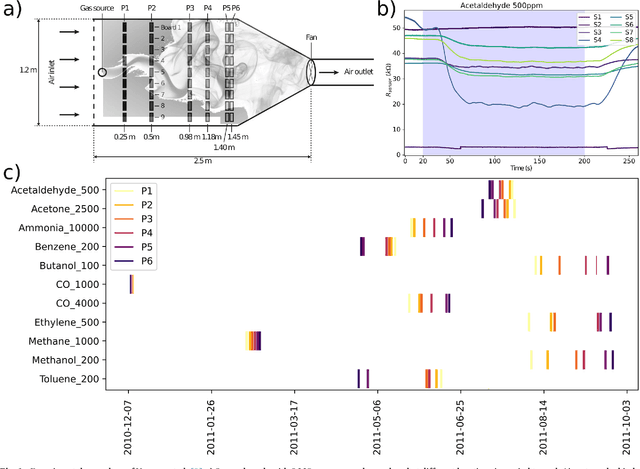
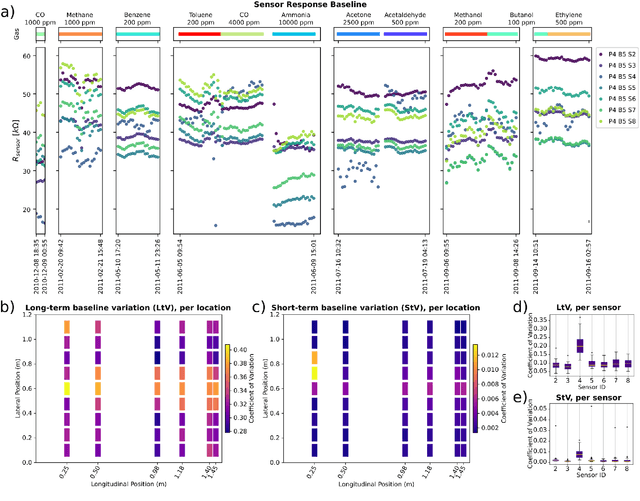
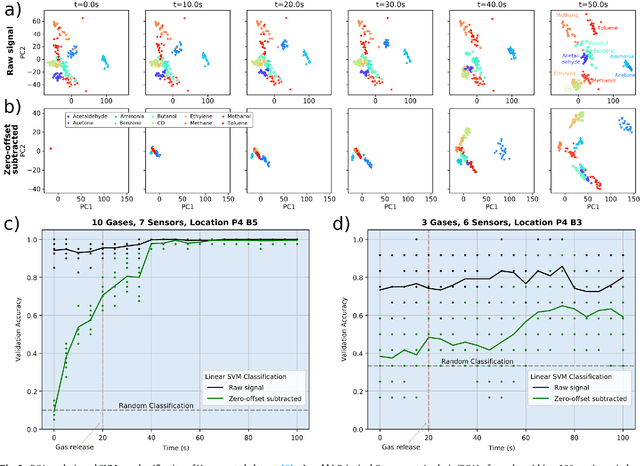
Abstract:Metal oxide (MOx) electro-chemical gas sensors are a sensible choice for many applications, due to their tunable sensitivity, their space-efficiency and their low price. Publicly available sensor datasets streamline the development and evaluation of novel algorithm and circuit designs, making them particularly valuable for the Artificial Olfaction / Mobile Robot Olfaction community. In 2013, Vergara et al. published a dataset comprising 16 months of recordings from a large MOx gas sensor array in a wind tunnel, which has since become a standard benchmark in the field. Here we report a previously undetected property of the dataset that limits its suitability for gas classification studies. The analysis of individual measurement timestamps reveals that gases were recorded in temporally clustered batches. The consequential correlation between the sensor response before gas exposure and the time of recording is often sufficient to predict the gas used in a given trial. Even if compensated by zero-offset-subtraction, residual short-term drift contains enough information for gas classification. We have identified a minimally drift-affected subset of the data, which is suitable for gas classification benchmarking after zero-offset-subtraction, although gas classification performance was substantially lower than for the full dataset. We conclude that previous studies conducted with this dataset very likely overestimate the accuracy of gas classification results. For the 17 potentially affected publications, we urge the authors to re-evaluate the results in light of our findings. Our observations emphasize the need to thoroughly document gas sensing datasets, and proper validation before using them for the development of algorithms.
Low-Power Neuromorphic Hardware for Signal Processing Applications
Jan 11, 2019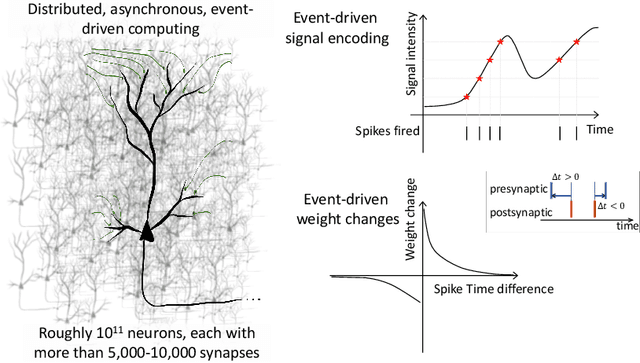
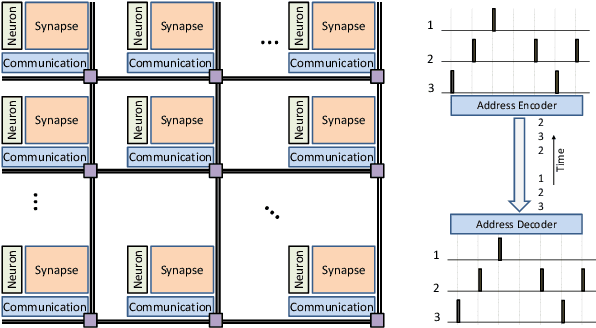
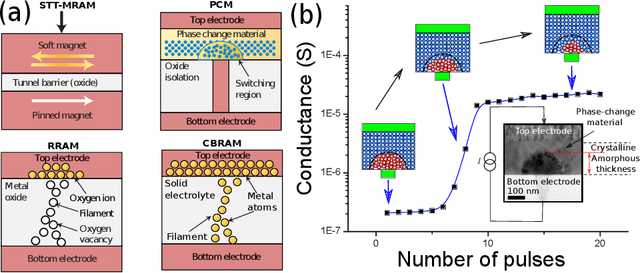
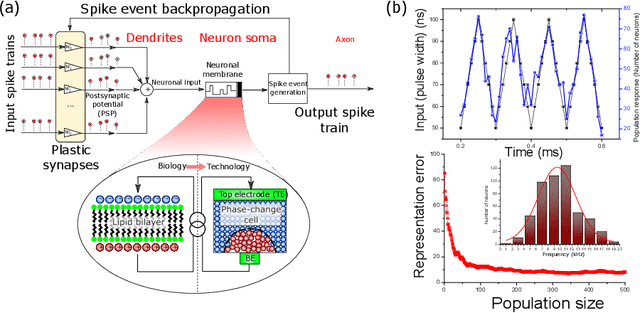
Abstract:Machine learning has emerged as the dominant tool for implementing complex cognitive tasks that require supervised, unsupervised, and reinforcement learning. While the resulting machines have demonstrated in some cases even super-human performance, their energy consumption has often proved to be prohibitive in the absence of costly super-computers. Most state-of-the-art machine learning solutions are based on memory-less models of neurons. This is unlike the neurons in the human brain, which encode and process information using temporal information in spike events. The different computing principles underlying biological neurons and how they combine together to efficiently process information is believed to be a key factor behind their superior efficiency compared to current machine learning systems. Inspired by the time-encoding mechanism used by the brain, third generation spiking neural networks (SNNs) are being studied for building a new class of information processing engines. Modern computing systems based on the von Neumann architecture, however, are ill-suited for efficiently implementing SNNs, since their performance is limited by the need to constantly shuttle data between physically separated logic and memory units. Hence, novel computational architectures that address the von Neumann bottleneck are necessary in order to build systems that can implement SNNs with low energy budgets. In this paper, we review some of the architectural and system level design aspects involved in developing a new class of brain-inspired information processing engines that mimic the time-based information encoding and processing aspects of the brain.
 Add to Chrome
Add to Chrome Add to Firefox
Add to Firefox Add to Edge
Add to Edge